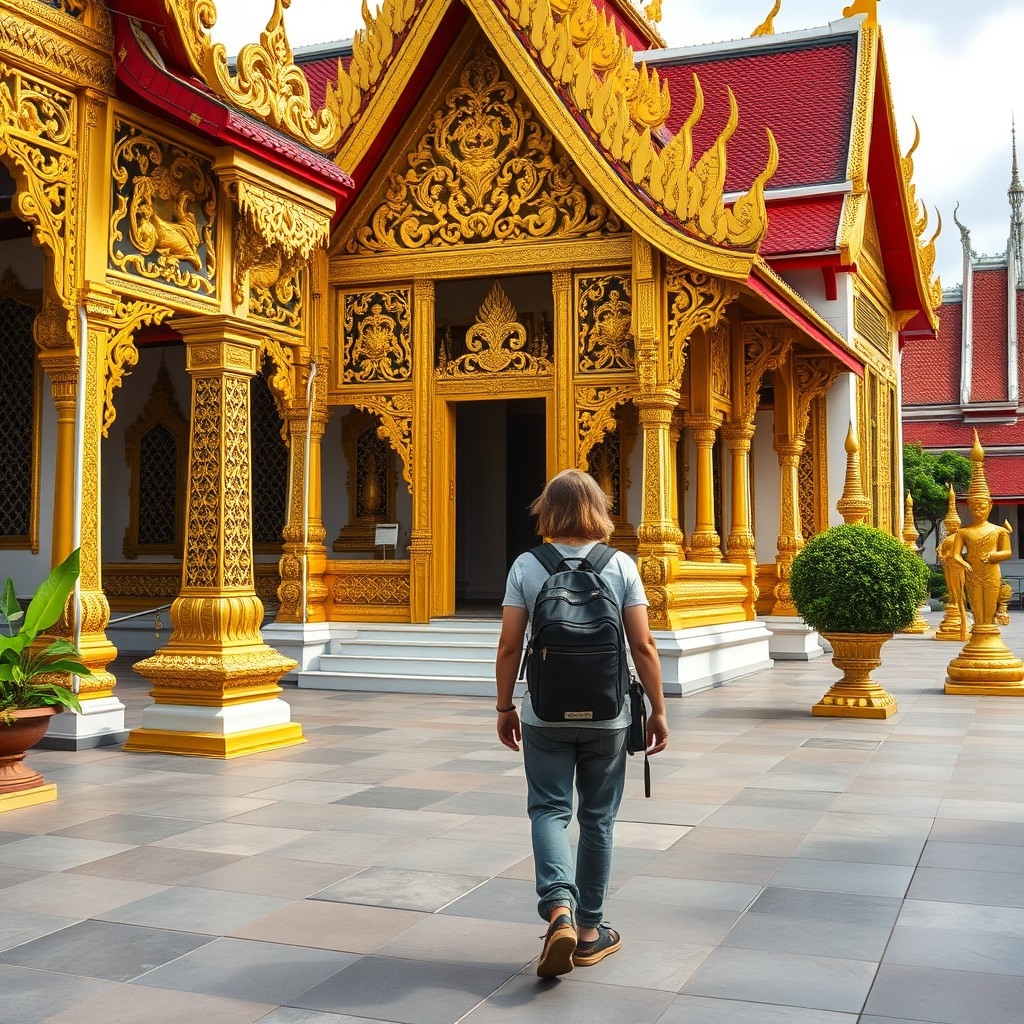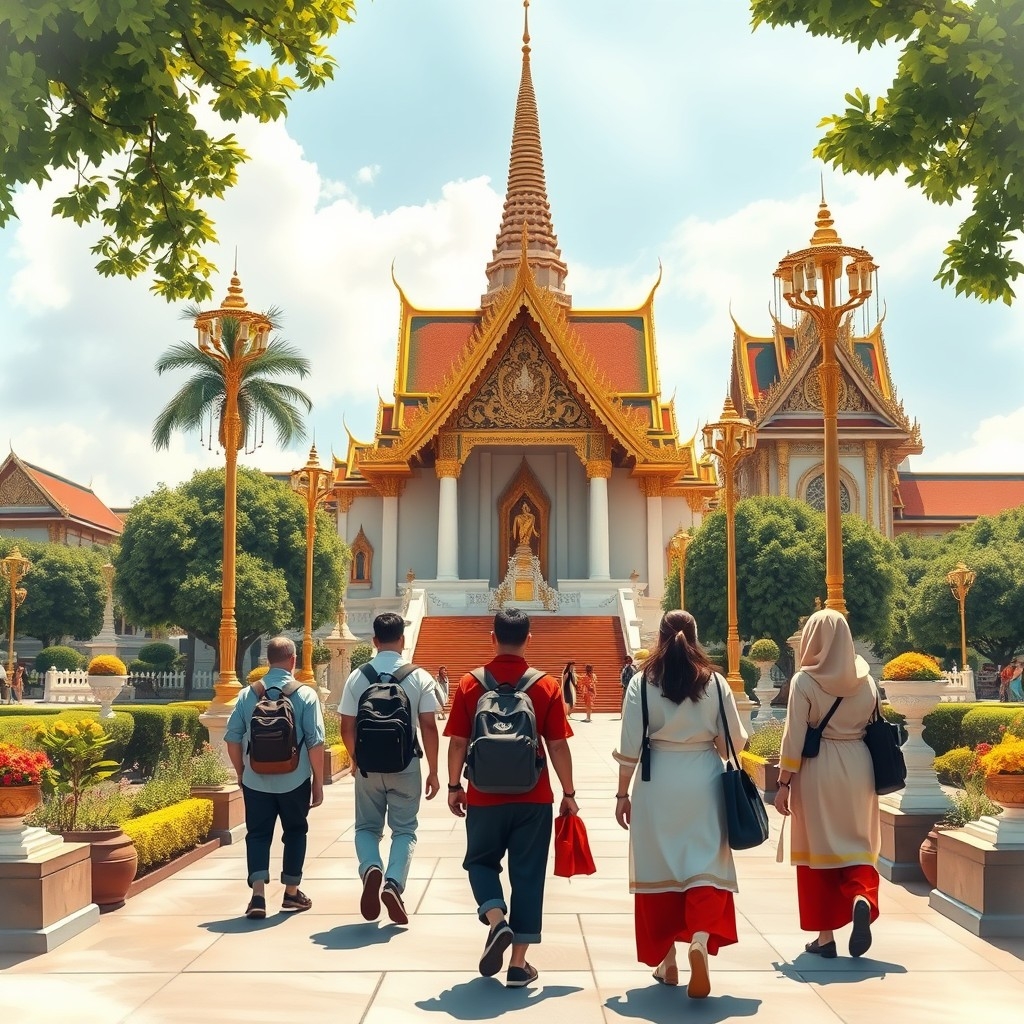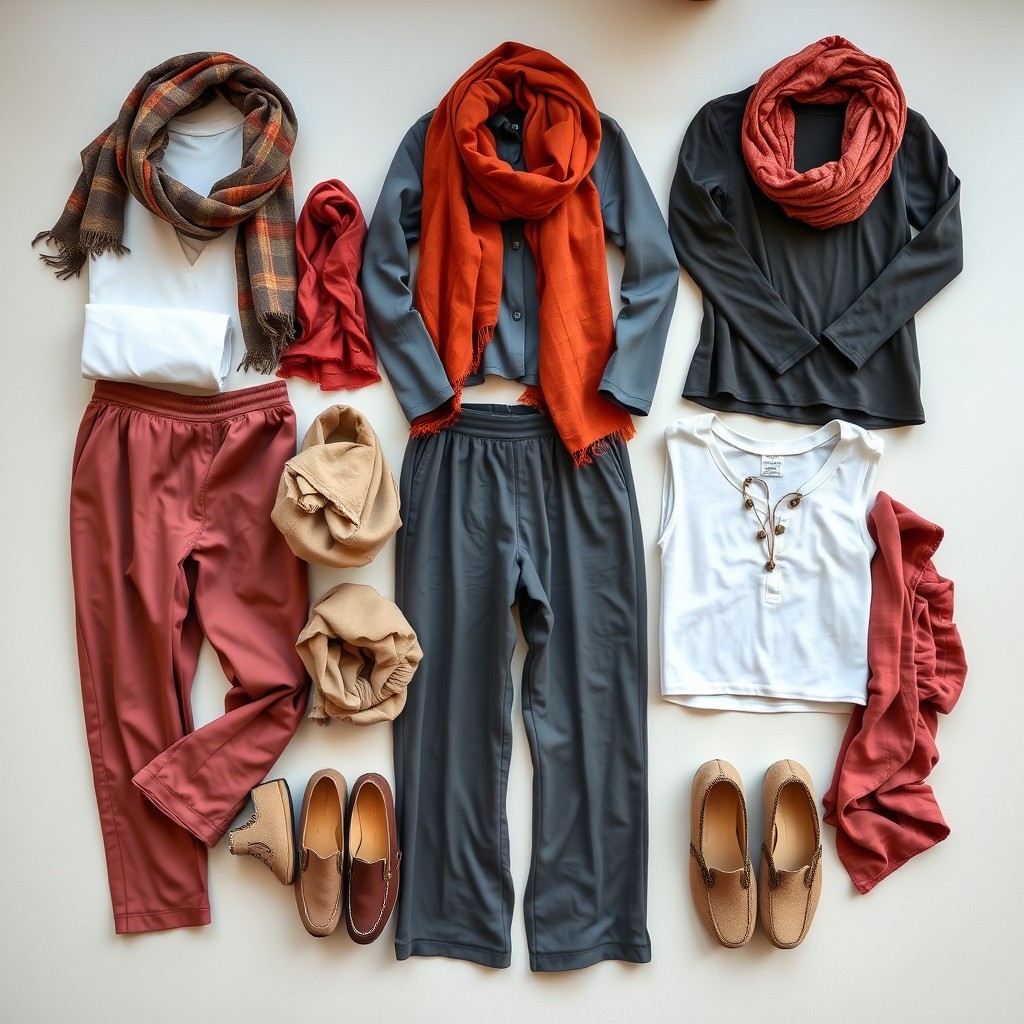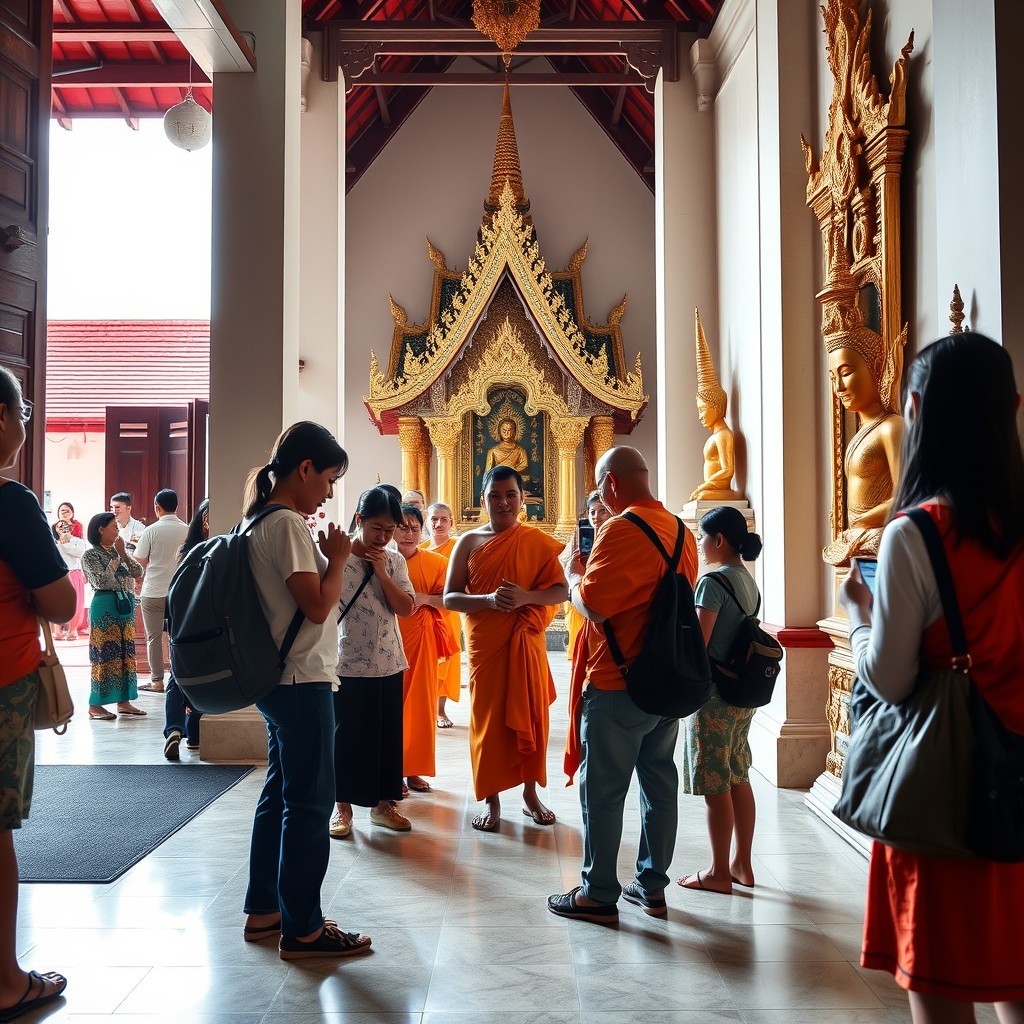Dress Code for Visiting Temples in Thailand
Find out what to wear when visiting Thailand's temples to honor traditions and have a respectful experience.
Imagine standing before the shining Wat Phra Kaew or the peaceful Wat Arun, ready to dive into age-old traditions. They are gorgeous! You definitely don't want to be turned away because of what you're wearing. Visiting temples is often a highlight of a trip to Thailand. These visits let you see the country's rich spiritual culture. Dressing properly isn't just about following rules; it's about showing respect for Thai customs. Let's make sure you're ready for an amazing temple visit!

Why Modesty Matters
In Thai culture, modesty shows respect, especially in religious places. Temples are where locals pray, make offerings, and meditate. By dressing modestly, you respect their beliefs and traditions. So, what does modest dressing look like in Thailand?
Guidelines for Women
Cover Shoulders and Knees
Ladies, you should wear clothes that cover your shoulders and knees. Choose long skirts, dresses, or pants. Tops need sleeves—short or long—to fully cover your shoulders. Sleeveless shirts, tank tops, or spaghetti straps aren't suitable.
Avoid Revealing Clothes
Don't wear clothes that are low-cut, see-through, or too tight. You want to look respectful, so save revealing outfits for another time. Pick loose-fitting clothes made from light fabrics to stay cool in the heat.
Footwear
You usually need to take off your shoes before entering temples. Wearing sandals or slip-on shoes makes it easier. If you don't like walking barefoot, bring some socks to wear inside.
Keep Accessories Simple
Accessories can make an outfit nicer, but it's best to keep them simple in temples. Flashy jewelry or big hats can be distracting and draw unwanted attention. Keeping it simple helps you look respectful.
Guidelines for Men
Wear Long Pants
Guys, shorts usually aren't okay in temples. Wear long pants that cover your knees and ankles. Light materials like cotton or linen can help you stay cool while following the dress code.
Shirts with Sleeves
A simple t-shirt or a collared shirt with sleeves is good. Avoid sleeveless tops or tank tops. Your shirt should fully cover your shoulders.
Footwear
Like women, you need to take off your shoes in some areas. Slip-on shoes or sandals are handy and save time. If you don't want to be barefoot inside, bring some socks.
No Hats Inside
Wearing a hat inside temples is disrespectful. Remember to take off any hats before going in.
Dress Code for Children
Kids often get more flexibility, but it's good to have them dress modestly too. This shows respect and teaches them about other cultures. Have them wear clothes that cover their shoulders and knees, just like adults.
Best Fabrics for Thailand's Weather
Thailand is hot and humid. Picking the right fabrics helps you stay comfortable and follow the dress code.

Cotton: Light and breathable, great for hot weather.
Linen: Also breathable and helps you stay cool.
Rayon: Light and smooth but can wrinkle easily.
Avoid Synthetic Fabrics: Things like polyester can trap heat and make you feel hotter.
Seasonal Tips
Hot Season (March to June)
In the hottest months, wearing light-colored clothes can help reflect sunlight. Breathable fabrics are a must. Bring a small fan or umbrella for shade.
Rainy Season (July to October)
An umbrella or light rain jacket is useful. Temples can be slippery when wet, so wear shoes with good grip.
Cool Season (November to February)
It's cooler, but you should still dress modestly. A light scarf or shawl can keep you warm in the early morning or evening.
Cultural Etiquette Beyond Clothing
Remove Your Shoes
You usually take off your shoes before going into temple buildings. Look for signs or watch what the locals do. There are usually spots to put your shoes.
Speak Softly
Temples are places for quiet and reflection. Keep your voice down to keep the peaceful feeling.
Respect Sacred Areas
Some parts of a temple are for monks or special rituals. Watch for signs or barriers, and don't go into restricted areas.
Show Respect to Monks
If you meet monks, greet them with a slight bow and the "wai" gesture—palms together at chest level. Women should not touch monks because of religious rules.
Cultural Mistakes to Avoid
Don't Point Your Feet
In Thailand, feet are seen as the lowest part of the body. Don't point your feet at Buddha images or people. When sitting, tuck your feet under you.
Don't Touch Buddha Statues
It might be tempting to touch or pose with statues, but this is disrespectful. Admire them from a distance.
Be Careful with Photography
Always look for signs about photography rules. Flash photography is often not allowed. Be careful when taking pictures of monks or people praying—ask for permission first.
Watch Your Body Language
Don't put your hands on your hips or cross your arms, as these can seem rude or confrontational.
Choosing Colors
There aren't strict rules about colors, but it's good to wear muted or neutral tones. Bright, flashy colors or loud patterns might not be appropriate in the quiet temple setting. Earthy tones like beige, brown, or olive are good options.

Dress Codes May Vary
Some temples have stricter dress codes. For example, Wat Phra Kaew in Bangkok has very strict rules and offers clothing rentals if you're not dressed properly. Smaller, local temples might be more relaxed, but it's safest to dress modestly wherever you go.
If You're Not Dressed Properly
If you reach a temple and you're not dressed appropriately, there are often solutions:
Clothing Rentals: Big temples often rent sarongs, pants, or shawls for a small fee.
Nearby Vendors: Vendors outside may sell cheap wrap-around skirts or scarves.
Carry Extra Layers: Keep a light scarf or shawl in your bag as a backup.
Packing Tips for Temple Visits
Light Scarves or Shawls: Great for covering shoulders or adding modesty.
Loose Pants or Long Skirts: Comfortable and appropriate.
Breathable Tops with Sleeves: Keeps you cool and covers your shoulders.
Slip-On Shoes or Sandals: Makes taking off shoes easy.
Socks: If you prefer not to be barefoot inside.
Hat and Sunglasses: Wear outside, but take them off indoors.
Water Bottle: Stay hydrated, but don't bring food or drinks into temple buildings.
Easy Outfit Ideas
For Women
Maxi Dress with Sleeves: Looks good and follows the dress code.
Loose Blouse and Long Skirt: Comfortable and good for the weather.
Light Pants and Short-Sleeved Top: Good for walking and sightseeing.
For Men
Linen Pants and Cotton Shirt: Keeps you cool and modest.
Khaki Pants and Polo Shirt: A neat option.
Light Jeans and T-Shirt: Okay if they're not ripped.
Why Dressing Right Matters
Dressing properly shows humility and respect in a sacred place. It's not just about rules; it's about visiting a place of worship with the right mindset. By following the dress code, you join a tradition that values respect and mindfulness.
Other Things to Keep in Mind
Food and Drink
Eating or drinking inside temple buildings is usually not allowed. Finish snacks before entering and throw away trash properly.
Smoking
Smoking is not allowed in temple areas. This includes e-cigarettes.
Donations
Giving a small donation is nice. There are often donation boxes near the entrance or inside the temple.
Language
Not everyone speaks English, but learning a few Thai phrases like "hello" (sawatdee) and "thank you" (khop khun) can improve your interactions.

Extra Tips for a Respectful Temple Visit
Be Quiet: Keep talking to a minimum inside temple buildings.
Follow Rules: Pay attention to signs and guidelines from the temple.
Stay on Paths: This helps protect the temple grounds and sacred areas.
Throw Away Trash Properly: Keep the temple clean for everyone.
Wrapping Up
Thailand's temples give you a deep look into the country's spiritual and cultural heart. By dressing modestly and following local customs, you show respect and make your experience better. So pack smart, dress properly, and get ready to explore these amazing temples with confidence and respect!
FAQ
Can I wear flip-flops to Thai temples?
Yes, flip-flops or sandals are fine because you'll need to take off your shoes in some areas. They make it easier and faster.
Do men need to cover their knees in Thai temples?
Yes. Men should wear long pants that cover knees and ankles. Shorts are usually not okay for temple visits.
Can I wear jeans to a Buddhist temple?
Yes, if they're not ripped or too tight. Jeans should cover your knees and ankles to be modest.
Is there a dress code for temples?
Yes. Men and women should dress modestly, covering shoulders and knees. Avoid revealing or tight clothes.
Can I wear leggings to a temple?
You can wear leggings if you pair them with a long top or dress that covers to the knees. Since leggings are tight, balance them with a modest top.
Can I wear sleeveless tops if I cover my shoulders with a scarf?
Some temples might allow this, but others might not. It's safer to wear a top with sleeves so you won't have any problems.
Do I need to remove accessories like sunglasses or hats?
Yes. Take off hats and sunglasses inside temples to show respect.
Can I bring a camera into the temple?
Yes, but always check for signs about photo rules. Flash photography is often not allowed, and some places may ban photos completely.

I'm a digital nomad and travel enthusiast. I love exploring new places and sharing my experiences and tips with fellow travelers.

I'm a digital nomad and travel enthusiast. I love exploring new places and sharing my experiences and tips with fellow travelers.